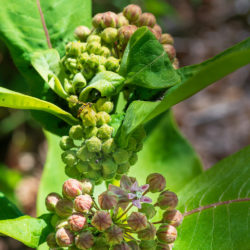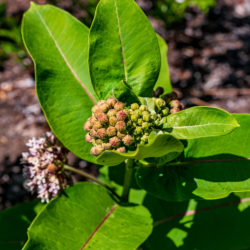Etymology
Asclepias is Greek for Asklepios, the god of medicine; syriaca is from Latin, pertaining to an origin in Syria (although this was an incorrect assumption on the part of Linnaeus; this plant is native to eastern North America).
Native Habitat
Sunny, well-drained open areas.
Garden Uses
This is the best milkweed for colonizing disturbed sites, as it tolerates dryer areas but is aggressive in garden beds. Often used in butterfly gardens or sanctuaries. Prefers full sun, but may tolerate light shade.
Overview
A perennial herb, typically 3 to 5 feet tall. Adaptable and found in a variety of sunny, well-drained habitats, from crop lands to open fields. It does not compete well, and often is found in ditches or other newly disturbed areas, but not in mature grasslands. When it spreads by rhizomes, it can form very large clonal colonies.
Leaves and Stems
Leaves are 4 to 8 inches long, grow oppositely, each on a short stem (petiole), with a prominent mid-rib beneath. They are oblong and typically pointed, deep green on top and paler on the underside. Each stout, erect stem bears 3 or more flower clusters, with each flower on its own short (1-1/2 inch) stem or pedicel.
Flowers
Large, slightly pendulous, spherical-appearing flower clusters (umbels), with 30 to 100 small greenish pink, light pink, or lavender fragrant flowers in each cluster. Each small flower has five 1/3-inch petals, fused into a cup, and flexed backward to expose the protruding hoods and horns.
Fruit/Seed
Follicles are approximately 3½ inches long, firm, elliptical, and inflated, with a widest diameter of up to 2 inches, and a sharp, narrow tip. They are covered with hair and soft spikes. They dry from green to gray, and split open in autumn to early winter, dispersing 50 to 100 brown seeds with downy tufts (coma), that are then disseminated by the wind.
Wildlife Associates
Over 450 insect species are known to feed on some portion of this plant. Flowers attract numerous pollinators. Leaves are a larval host to several species, including monarch butterflies (Danaus plexippus). Due to toxic glycosides in the plant, when the leaves are eaten by monarch butterfly larvae as a sole food source, both larvae and resulting adult butterflies become toxic to birds and other predators. Many of the other insects that feed on this milkweed have an orange-red and black (aposematic) coloration, a showy advertisement that they are not good to eat.
Propagation
Seeds or rhizomes (cut and transplant in the spring).
Ethnobotanical Uses
Human consumption of milkweed is not recommended due to toxic compounds it contains. The seed fluff (coma) has been used to stuff life vests and pillows, and the milky latex resin, which exudes when stem or leaf are injured, has been used topically for wart removal.
Sources
Lady Bird Johnson Wildflower Center
US Forest Service Plant of the Week
Plant Profile by Kate O’Dell


